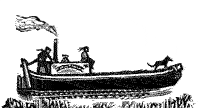HERITAGE ITEM
The Oxford Canal

The canal today is used for residential boats as well as leisure boats
A brief history of Jericho's waterway
Posted - Nov 08, 2012
The Oxford Navigation Company was floated in 1769 and received enthusiastic support from both the City and University. At that time the country was suffering some of the hardest winters of the Little Ice Age when the average January temperatures were 2.5°C lower than the present day and prolonged heavy snowfalls regularly blocked the roads. The prospect of a cheap, reliable and fast means of bringing coal, raw materials and manufactured goods from the growing industrial centres of the West Midlands to Oxford was very enticing. Funds were soon raised and James Bradley appointed as surveyor and engineer to build a 91-mile canal from Hawkesbury, just north of Coventry, to Oxford. The first section to Banbury was completed by 1778 and by 1788 the canal had reached Hayfield Hutt, the old tavern by Aristotle Lane, now replaced by the Anchor. Here a coal wharf was built. The last section into Oxford which included the terminal basin and wharves along New Road was opened on 7th January 1790 with a civic ceremony; the price of coal fell about eightfold. The canal was built to a minimum bed width of 16 ft and a depth of 5ft throughout its length allowing two standard narrow boats to pass. It was flanked by a 7ft wide towpath and numerous narrow bridges were built to permit the tow horses to cross from side to side and local bridges for carts and wagons.
Until the Grand Union Canal was finished in 1794 the Oxford canal was the fastest means of getting from the Midlands to London. That it made steady profits can be seen from the magnificent Wyaston Hall in New Inn Hall Street which was its first company offices. This is now the entrance to St. Peter's College. The company was affected by the building of the railways in 1850 and in 1878 the offices were moved to Canal House on Bulwarks Lane, now the lodgings of the Master of St. Peter's.
The first firm in Jericho to take advantage of a canal site was Carter Ironworks in 1825. Five years later Henry Ward built his coal wharf at the end of what is now Nelson Street. Further growth was delayed by waterlogged ground but by the end of the 1870s the whole front was built up, with a chain ferry over the canal at Ferry Road, renamed Combe Road in 1959. The footbridge to the north is very recent, about 1976.
Trade engendered by the canal prospered until the end of the 19th century by which time it was being undercut by the railways; nor were the railways latterly doing much better. Finally in 1937 Lord Nuffield bought the terminal basin and its wharves on which to build his new college and the canal was terminated at Hythe Bridge Street. Trade continued at a low level with a slight resurgence during the 1939-45 war; in 1942 223 barges docked in Oxford. Commercial traffic virtually ceased on the southern section of the canal in 1956 when only 16 barges were recorded. Most vessels now using the canal are pleasure boats. A few are houseboats. All the wharves are now closed. The last to go was the Jericho wharf where barge conversions were carried out and pleasure boats serviced.
This is an extract from the Jericho Sketchbook by Christine Cowham and Norman Pollock. The full text is of the book available at Jericho Online.
Other heritage items
Thomas Hardy in Jericho 
Thomas Hardy |
The Bohemian Republic of Jericho 
|
The Pre-Raphaelites 
The First Anniversary of the Death of Beatrice by Dante Gabriel Rosetti |
The Oxford Canal 
The canal today is used for residential boats as well as leisure boats |
Wharf history 
Until the 1960s the only way to cross the canal in Jericho was via the ferry |
Artistic links 
Betjeman campaign poster |